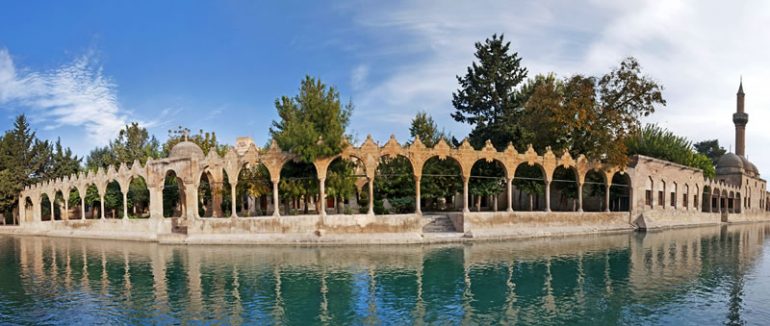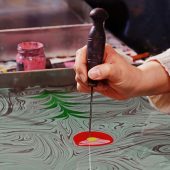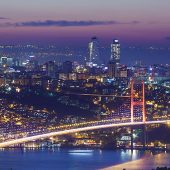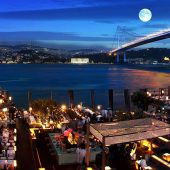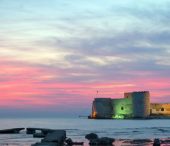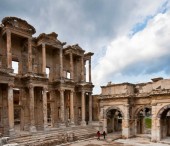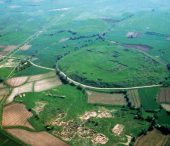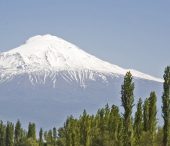Şanlıurfa (often simply known as Urfa in daily language), formerly cited as Edessa or in Kurdish; Riha or Urhāy, or in Armenian Urhai) is a city in south-eastern Turkey, and the capital of Şanlıurfa Province. Urfa is situated on a plain under big open skies, about eighty kilometres east of the Euphrates River. The climate features extremely hot, dry summers and cool, moist winters. The urban population of Urfa is mainly Turkish while the outlying regions are mixed Kurdish and to a lesser degree Arabian.
Etymology
The city has been known by many names in history: Ուռհա, Urhai in Aramaic, ܐܘܪܗܝ, Riha in Syriac, الرها, Ar-Ruha in Arabic, Ορρα, Orrha in Greek (also Ορροα, Orrhoa). For a while it was named Callirrhoe or Antiochia on the Callirhoe (Greek: Αντιόχεια η επί Καλλιρρόης). During Byzantine rule it was named Justinopolis. Although, prior to the Turkish rule, it was often best known by the name given it by the Seleucids, Εδεσσα, Edessa.
'Şanlı' means great, glorious, dignified in Turkish and Urfa was officially re-named Şanlıurfa (Urfa the Glorious) by the Turkish Grand National Assembly in 1984, in recognition of the local resistance in the Turkish War of Independence. The title was achieved following repeated requests by the city's members of parliament, desirous to earn a title similar to those of neighbouring rival cities 'Gazi' (veteran) Antep and 'Kahraman' (Heroic) Maraş.
History
The history of Şanlıurfa is recorded from the 4th century BC, but may date back to the 8th century BC, when there is ample evidence for the surrounding sites at Duru, Harran and Nevali Cori. It was one of several cities in the Euphrates-Tigris basin, the cradle of the Mesopotamian civilization. According to Turkish Muslim traditions Urfa (its name since Byzantine days) is the biblical city of Ur, due to its proximity to the biblical village of Harran. However, the Iraqis also claim the city of Ur in southern Iraq, as do many historians and archaeologists.
Urfa is also known as the birthplace of Abraham, commemorated by a mosque in the city and the birthplace of Job.
Urfa was conquered repeatedly throughout history, and has been dominated by many civilizations, including the Ebla, Akkadians, Sumerians, Babylonians, Hittites, Hurris, Armenians, Mittannis, Assyrians, Chaldeans, Medes, Persians, Macedonians (under Alexander the Great), Seleucids, Arameans, Osrhoenes, Romans, Sassanids, Byzantines, Crusaders.
The city of Edessa
In the Byzantine period Edessa was a powerful regional centre, and a sophisticated city with churches, schools and monasteries.
The age of Islam
Islam first arrived around 639 C.E., when the Umayyad army conquered the region without a fight. Islam was then established permanently in Urfa by the empires of the Ayyubids, Seljuk and Ottoman Turks. In the aftermath of the First Crusade, the city was the center of the Crusader County of Edessa, until 1144, when it was again captured by the Turk Zengui, and most of its inhabitants were slaughtered together with the Latin archbishop (see Siege of Edessa). For the ten years following the Turkish capture, Urfa was at the center of European history, since the very reason for which the Second Crusade was launched was the city's recapture. While it began with an enthusiastic massacre of Jews in western Europe and the presence of an Emperor and a King of France gave it much lustre, it was a disaster, its only success recorded resulting from auxiliary operation when an English fleet took from the Arabs and passed into the hands of the future King of Portugal the city of Lisbon.
Under the Ottomans Urfa was a centre of trade in cotton, leather, and jewellery. There were three Christian communities: Syrian, Armenian, and Latin. The last Syrian Christians left in 1924 and went to Aleppo (where they settled down in a place that later got called Hay al-Suryan "The Syriac Quarter").
The First World War and after
In 1914 Urfa was estimated to have 75,000 inhabitants: 45,000 Kurds and Turks, 25,000 Armenians and 5,000 Syrian Christians. There were also some Jews.
At the end of World War I, with the Ottoman Empire defeated, and European armies attempting to grab parts of Anatolia, first the British and then the French occupied Urfa. The British occupation of the city of Urfa started de facto on 7 March 1919 and officially as of 24 March 1919, and lasted till 30 October 1919. French forces took over the next day and their uncomfortable presence, met by outbursts of resistance, lasted until 11 April 1920, when they were defeated by local resistance forces (the new Turkish government in Ankara not being established, with the National Assembly declared on 23 April 1920.
The French retreat from the city of Urfa was conducted under an agreement reached between the occupying forces and the representatives of the local forces, commanded by Captain Ali Saip Bey assigned from Ankara. The withdrawal was meant to take place peacefully, but was disrupted by an ambush on the French by irregular forces at the Şebeke Pass on the way to Syria, leading to 296 casualties among the French, and more among the ambushers.
Şanlıurfa today
The skyline of Şanlıurfa as viewed from the Castle which dominates the City Centre.Modern Şanlıurfa presents stark contrasts between its old and new quarters. The old town is one of the most evocative and romantic in Turkey, with an ancient bazaar still visited by local people to buy fruit and vegetables, where traditionally dressed and scarfed Arab and Kurdish villagers arrive in the early morning to sell their produce. Much of the old town consists of traditional Middle Eastern houses built around courtyards, invisible from the dusty streets, many of which are impassable to motor vehicles. In the narrow streets of the bazaar people scurry to and fro carrying trays of food, which is eaten on newspapers spread on low tables in a corner of the little shops, many people drinking water from the same cup. This very oriental atmosphere is bewitching but below the surface parts of the old city are very poor indeed, with people still living in cave houses (built into the side of the rock).
Şanlıurfa's newer districts meanwhile, are a sprawl of modern concrete apartment blocks, with many surprisingly tidy leafy avenues, containing modern restaurants, sports facilities and other amenities with air-conditioning, a refuge from the roasting summer heat.
Food and drink
The cuisine is typical of the south-east; bread and meat are at the centre either kebab, doner or kavurma (fried meats or liver), with lots of use of aubergine, tomato and hot pepper, including the legendary local red pepper isot. Other dishes include: the spicy appetiser çiğ köfte (in Urfa even spicier than usual); the rich sweets such as the hot butter and syrup künefe or the walnut pastry sillik; the bitter Arabic-style coffee mırra and the coffee-like drink made from Terebinth menengiç kahvesi.
(The legend of isot goes that during the French occupation in the 1920s the people of Urfa were at first not much concerned about the town being invaded or losing their homes and only began the resistance when they saw the French marching in the pepper fields. Now they even make isot flavoured ice-cream.
Urfa is not a huge metropolis and in many ways feels like a conservative country town (albeit a largish one). You will not be served an alcoholic drink with your dinner in Urfa and even the tea-gardens (the only public social venue that Urfa provides) are strictly segregated for families or single-men (not the case in western Turkey for example). One local tradition is the sıra gecesi, where groups of men gather at home, especially in winter evenings, to play lutes (ud or bağlama) and sing folk songs. However, today there are a couple of smart hotels where you can get a drink and with the new economic growth, plus the growing university, Urfa's social infrastructure must surely develop soon.
Places of interest
A traditional birthplace of the prophet Abraham - a cave to the south of the city
Urfa castle - built in antiquity, the current walls were constructed by the Abbasids in 814AD.
The legendary Pool of Sacred Fish (Balikligöl) where Abraham was thrown into the fire by Nimrod. The pool is in the courtyard of the mosque of Halil-ur-Rahman, built by the Ayyubids in 1211 and now surrounded by attractive gardens designed by architect Merih Karaaslan. The fish are not a pretty sight as they thrash about frantically devouring bread thrown by visitors. But the courtyard is very peaceful and it is said that if you see a white fish you will go to heaven.
Rizvaniye Mosque - a more recent (1716) Ottoman mosque, adjoining the Balikligöl complex.
Ayn Zeliha - another pool nearby, named after a lady follower of Abraham.
The Great Mosque of Urfa was built in 1170, on the site of a Christian church the Arabs called the "red church," probably incorporating some Roman masonry. Contemporary tradition at the site identifies the well of the mosque as that into which the towel or burial cloth (mendil) of Jesus was thrown (see Image of Edessa and Shroud of Turin). In the south wall of the medrese adjoining the mosque is the fountain of Firuz Bey (1781).
Ruins of the ancient city walls.
Eight Turkish baths built in the Ottoman period.
The traditional Urfa houses were split into sections for family (harem) and visitors {selam). There is an example open to the public next to the post office in the district of Kara Meydan.
The Temple of Nevali Cori - Neolithic settlement dating back to 8000BC, now buried under the waters behind the Atatürk Dam, but some artefacts relocated above the waterline.
Gobeklitepe - The world's oldest known stone temples (dated to before 9000 BC). Göbekli Tepe

